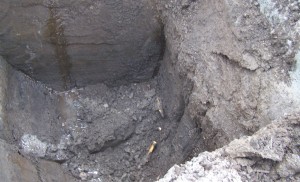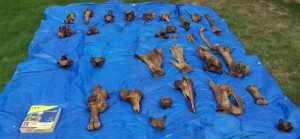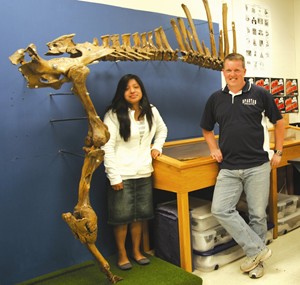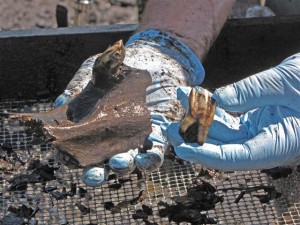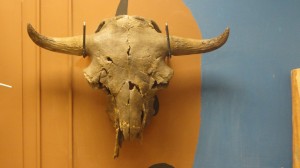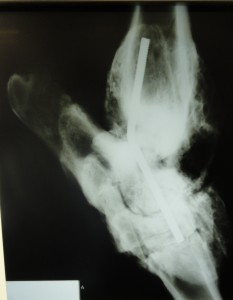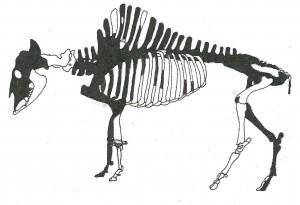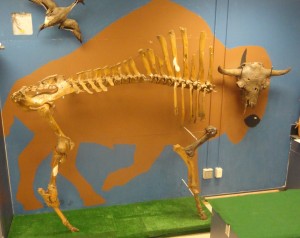Bison antiquus
It’s mid-September in the Willamette Valley. The end of the ice age is near. A solitary bison limps beside a slow-moving shallow creek. The animal is huge, even compared to other ice age bison of his day. However, he is not well. His back right ankle is swollen to an abnormally large size which is why he can hardly move. He comes to a pond with steep hills on both sides. The water is deeper here, as much as a meter. He struggles to keep moving which causes him to sink into the thick mud of the bottom. Dire wolves, which have been following him for days see his distress but because of his intimidating size and the depth of the water they keep their distance. For the next few weeks the bison struggles to free himself, but it’s fruitless. Over half of his body remains stuck. Winter is earlier this year, and the rainfall is heavier than normal. Eventually the water level rises too high, and the bison’s fight to stay alive ends as he slumps below the surface of the water. For the remainder of this late ice age winter, sediment piles up over the body. By late spring, when the water level recedes there is no evidence that just centimeters below are the remains of an ice age giant.
A Big Find
In September of 2008 during the annual dig for Woodburn High School biology students, a nearly complete skeleton of a Bison antiquus was found. The bones were located about 18 feet below the surface in a level of sandy clay. Because of the depth of the trench, and the instability of the walls, students could not go into the pit to retrieve the bones. Therefore, the bones were brought to the surface using a track hoe. Students spent the next week sifting through the soil to find bones and bone fragments. As bones were taken out of the soil, they were put into containers of water where they remained until professional paleontologists could give advice on what to do next.
Dave Taylor of the Oregon Museum of Science and Industry (OMSI), and Dr. Alison Stenger of the Institute for Archaeological Studies (IAS) were the first paleontologists to look at the bones. They were amazed at the size of the bones, their incredible state of preservation, and the total number of bones. They were also able to determine that this was a very large male Bison antiquus, which was an ice age bison that was much larger than today’s bison. Closer analysis identified no predatory markings on the bones. This implied that when the animal died, it wasn’t eaten, or scavenged. Another interesting piece was a very large growth on the right back ankle. Clearly this growth was not normal, and further research would be needed to determine how much of an impact this growth had on the ending of the animals life. Most of the time, a single bone of an animal is found in a dig. On a few occasions a few bones of the same animal are discovered. It is truly unique to find a nearly complete skeleton. This skeleton would prove to be an excellent opportunity for high school students to conduct authentic scientific research. Some of the questions that would be researched: How big was this animal? How long ago did he die, and what caused his death? What caused the large pathological growth on his ankle, and did that play a role in his eventual death?
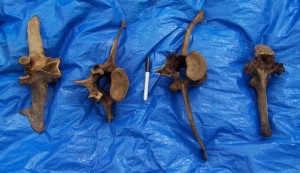
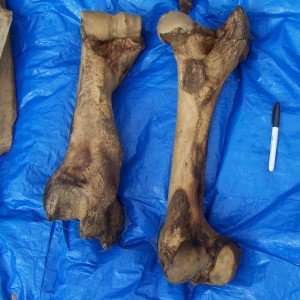
Working to Preserve and Display
According to instruction by Dr. Stenger, the bones were cleaned of their soil and over the next few weeks were soaked in a solution of future floor wax to help stabalize them even more. Odulia Flores was a senior at WeBSS, a small school on Woodburn High School campus, who worked with the bones as they soaked in the future solution. Every week, Odulia would take the bones out of the solution to let them dry for 10-15 minutes, then return them to the solution. After two months of soaking and drying, Odulia began to examine the bones to try and understand more clearly what was found. The goal of Odulia’s project, was to display as much of the skeleton as possible. Unfortunately, many of the bones were in fragments, so Odulia’s first job was to re-attach fragments together to make complete bones. This was a time consuming but intriguing jigsaw puzzle.
With the help of other students and school custodians, Odulia managed to put the entire back right leg, the pelvis, and the lumbar and thoracic vertebrae together, and display them on the back wall of the biology classroom. The process of putting the bones together, was done using various sizes of threaded rods and epoxy glues. It now became clear the immense size of the skeleton. The height from the top vertebrae to the toes measured seven and a half feet. With muscle, skin, and fur, this animal would easily have been eight feet in height. An impressive size. Community members, scientists, and curious amateurs have come to see Odulia’s work and all are amazed at the completeness and size of the skeleton. For the opportunity to work on bones of an ice age giant truly was a unique experience for a high school senior.
In August 2010, Dr. Alison Stenger of IAS, came to the High School with volunteers and Portland Community College students to hopefully find more of the skeleton. The dig site chosen was next to the 2008 site. To the excitement of those participating, a complete skull of a bison was found. The cranium and horn cores were in two pieces, while the rest of the skull was in fragments. Workers water screened through the soil to find over 500 skull fragments. Some of these fragments were thin sinus pieces, while others were larger fragments like the maxilla and teeth. Later in September during the annual high school dig, the right humerus of the bison was discovered. When the bone was brought to the classroom it was put together with the right ulna/radius. They fit perfectly. One difference between this bone and the rest of the skeleton, was that it was much darker in color. Were these bones part of the 2008 skeleton or did they belong to another individual?
Alejandra Casas a 2010/11 senior took it upon herself to assemble the skull. Like Odulia, Ale soaked the bones in a solution of Future Floor Wax. Some of the smaller fragments were soaked for a couple of weeks, while the larger bones soaked for two months. Once the soaking was finished, Ale started to reassemble the skull. Like the skeleton, this was a time consuming endeavor that required a great deal of patience, and a lot of trial and error. Eventually, the pieces started to take shape, and the majority of the skull was complete although the interior sinuses were not finished because of their intricate nature. From the skull, Ale could determine that the animal was indeed a male Bison antiquus. She also realized that the horn cores were relatively small in circumference which led her to conclude that the bison was not fully mature when it died. The skull was mounted beside the rest of the skeleton.
The Research Begins
In 2011, research began on the large pathological growth on the back right ankle. The bones were taken to a local veterinarian, Dr. Pau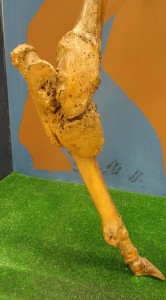 l Jones for observation. Dr. Jones took x-ray of the bones and after careful analysis and consultation with other veterinarians, he determined that the growth was caused by a wound from a predator or hunter that later became infected. As the infection festered it developed into a form of cancer called osteolmeylitis. Dr. Jones also observed that the size of the growth was unusually large. In nature most animals would have been killed before the growth achieved this size. This led Dr. Jones to believe that it was allowed to grow while the bison was isolated and immobilized for a few weeks or months. This new information, together with fact that there are no predatory markings on the bones, indicates that the bison was buried quickly when he did die. Also, it was evident that before the bison died, the cancer had spread to other parts of the skeleton. The sternum and some vertebrae showed severe signs of cancer, while the front right ankle was starting to display signs of abnormal growth.
l Jones for observation. Dr. Jones took x-ray of the bones and after careful analysis and consultation with other veterinarians, he determined that the growth was caused by a wound from a predator or hunter that later became infected. As the infection festered it developed into a form of cancer called osteolmeylitis. Dr. Jones also observed that the size of the growth was unusually large. In nature most animals would have been killed before the growth achieved this size. This led Dr. Jones to believe that it was allowed to grow while the bison was isolated and immobilized for a few weeks or months. This new information, together with fact that there are no predatory markings on the bones, indicates that the bison was buried quickly when he did die. Also, it was evident that before the bison died, the cancer had spread to other parts of the skeleton. The sternum and some vertebrae showed severe signs of cancer, while the front right ankle was starting to display signs of abnormal growth.
Another big question, was one of the first asked when the bones were discovered. How long ago did the bison die? Danny Gilmour of Portland State University was working on his thesis of Willamette Valley Mega-fauna and volunteered to have the skeleton radio-carbon dated. Below are the results of his investigation, which place the bison between 12, 909 and 13,603 years old.
|
AA Number |
Internal Lab # |
Measured Radiocarbon Age |
Calibrated Age Range |
|
AA87430 |
X15054UA |
11,320 ± 120 |
13,429-12,909 |
|
AA87430 |
X15054B |
11,310 ± 110 |
13,405-12,920 |
|
AA87431 |
X15055UA |
11,470 ± 100 |
13,567-13,127 |
|
AA87431 |
X15055 |
11,460 ± 120 |
13,603-13,108 |
To fully understand how the size of the bison compares with other bison in North America detailed meaurements needed to be taken. Over the last few years many students have been involved in gathering measurements of the bones. To help make accurate measurements “A Guide to the Measurement of Animal Bones from Archaeological Sites” by Angela Von Den Driesch was used to determine what specific measurement were to be made. Intial indications, are that the skeleton of the Woodburn bison is extremly large and in many cases the bones are the largest recorded on any B. antiquus. The skull, however, is very comparable to other B. antiquus skulls.
Below is a list of the measurements done so far. They are compared with measurements done on Bison antiquus from all over North America. The sources used were McDonalds North American Bison,1981, The Casper Site, The Horner Site, LaBrea and Paige Museum, Earlham College, and Eastern Oregon University. The lower end measurements are of females and/or juveniles. They were included in the comparison to help give a perspective on the size of the Woodburn bison.
| Measurements of the cranium of Bison antiquus | Woodburn Bison | Combined NA Bison |
| Greatest length of the nasals | 260 mm | |
| Greatest breadth across the nasals | 118 mm | |
| Greatest breadth across the orbits | 411 mm | 338-400 mm |
| Least frontal breath of the orbits | 330 mm | 276-357 mm |
| Least breadth between the bases of the horncores | 364 mm | 188-190 mm |
| Least distance between the horncore tips | 905 mm | 765-1090 mm |
| Least diameter of the horncore base (left) | 97 mm | 90 mm |
| Least diameter of the horncore base (right) | 105 mm | 90 mm |
| Horn core basal circumfrence (left) | 288 mm | 233-392 mm |
| Horn core basal circumfrence (right) | 297 mm | 233-392 mm |
| Greatest height of the occipital region | 216 mm | |
| Least height of the occipital region | 161 mm | |
| Height of the foramen maganum | 55 mm | |
| Greatest breadth of the foramen magnum | 55 mm | |
| Greatest breadth of the occipital condyles | 155 mm | 125-161 mm |
| Greatest mastoid breadth | 344 mm | |
| Greastest palatal breadth | 205 mm | |
| Length of the cheek row (left) | 165 mm | |
| Length of the cheek row (right) | 165 mm | |
| Length of the molar row (left) | 103 mm | 98.5-106 mm |
| Lenth of the molar row (right) | 104 mm | 98.5-106 mm |
| Length of the premolar row (left) | 65 mm | |
| Length of the premolar row (right) | 68 mm | |
| Greatest inner length of the orbit (left) | 66 mm | |
| Greatest inner length of the orbit (right) | 62 mm | |
| Measurements of the right radii of Bison antiquus | ||
| Greatest length | 422 mm | 262-372 mm |
| Greatest breadth of proximal end | 130 mm | 82-112 mm |
| Greatest breath of distal end | 122 mm | 75-104 mm |
| Smallest breadth of diaphysis | 73 mm | 36-69 mm |
| Measurement of the right ulna of Bison antiquus | ||
| Greatest length | 538 mm | 368-473 mm |
| Length of the olecranon | 191 mm | 39-153 mm |
| Smallest depth of olecranon | 94 mm | 51-77 mm |
| Greatest breadth of the proximal surface | 70 mm | |
| Measurements of the left humerus of Bison antiquus | ||
| Greatest length | 486 mm | 414-266 mm |
| Smallest breadth of diaphysis | 69 mm | 35-70 mm mm |
| Greatest breadth of trochlea | 123 mm | 70-103 mm |
| Greatest breath of distal end | 131 mm | 73-107 mm |
| Greatest length from head | 422 mm | 354-372 mm |
| Greatest breadth of proximal end | 163 mm | 92-132 mm |
| Measurements of the right humerus of Bison antiquus | ||
| Greatest length from head | 417 mm | 354-372 mm |
| Smallest breadth of diaphysis | 63 mm | 35-70 mm |
| Greatest breadth of distal end | 128 mm | 73-107 mm |
| Greatest breadth of trochlea | 115 mm | 70-103 mm |
| Measurements of the right femur of Bison antiquus | ||
| Greatest length | 556 mm | 406-476 mm |
| Smallest breadth of diaphysis | 62 mm | 40-52 mm |
| Greatest length from head of femur | 522 mm | 369-448 mm |
| Greatest breadth of distal end | 155 mm | |
| Greastest breadth of proximal end | 194 mm | 155-167 mm |
| Measurements of the right tibia of Bison antiquus | ||
| Greatest breadth of proximal end | 163 mm | 88-136 mm |
| Greatest depth of proximal end | 158 mm | 74-129 mm |
| Smallest breadth of diaphysis | 67 mm | 31-64 mm |
Because of the close proximity of the skull and the 2008 skeleton, it was assumed that they belonged to the same individual. A closer analysis of the skull shows an indentation that and penetration of the bone. A cast was made of this wound and determined to have been caused by a horn core of another bison. This would indicate that the skull represents another bison individual from that of the 2008 skeleton. Another piece of evidence comes from the measurements. The skeleton is larger that any other Bison antiquus skeleton found in North America, however, the skull fits within the normal measurements for a male bison. Also, the color of the skull matches the color of the right humerus that was found in 2010 as well as ribs and vertebrae that have been found since then. Evidence is strong, that the skull to the 2008 bison may still be in the ground, while the 2010 bison skeleton is slowly being dug up.
The question then to be asked is how many individual bison have been found in Woodburn?
